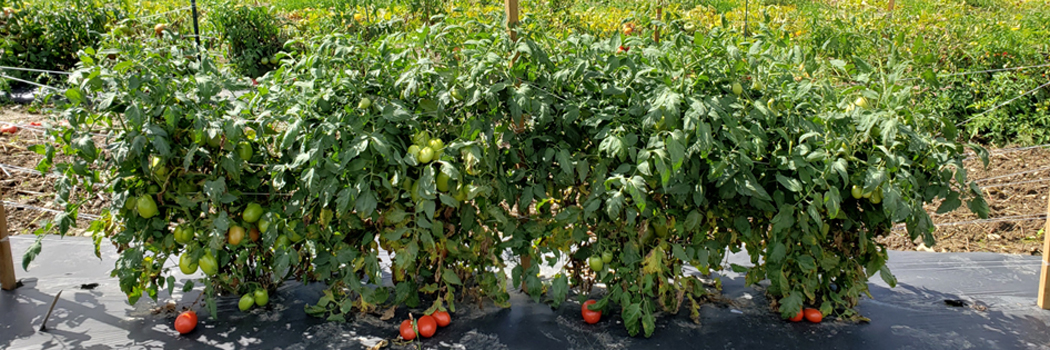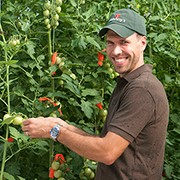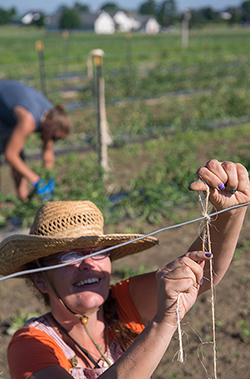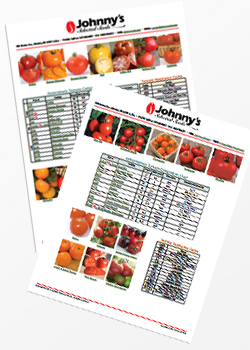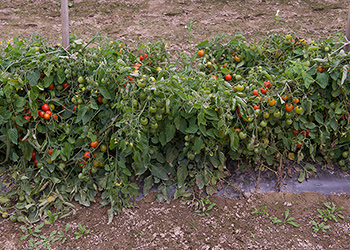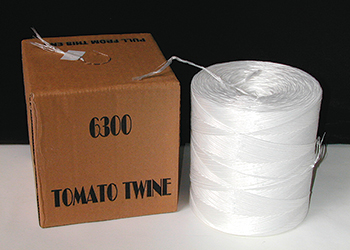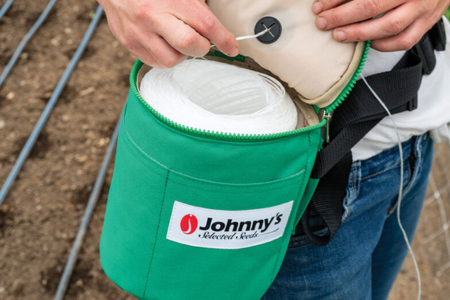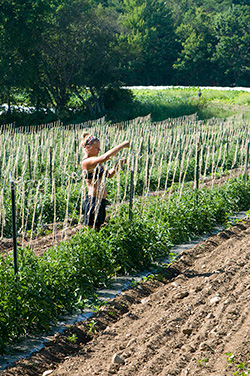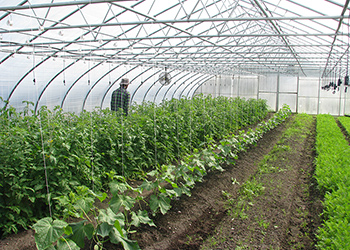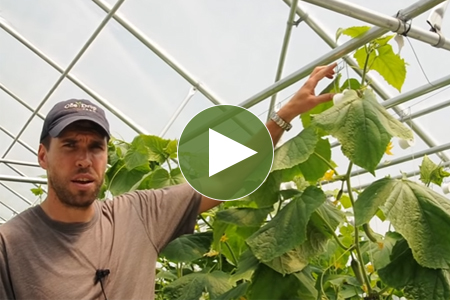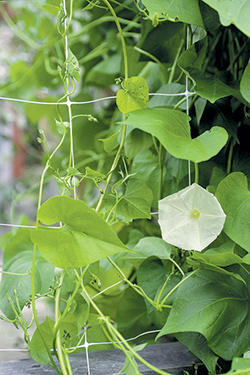- Hortonova & Trellinet | Instructions | Tech Sheet
- Cable Purlin Trellis for QuickHoops High Tunnels | Installation Manual (PDF)
- Rollerhook | Instructions for Use
- Rollerhook Replacement Spools | Instructions for Use
- Greenhouse Tomato Pruning & String Trellising | Tech Sheet (PDF)
- Basket-weave Trellising Instructions for Tomato & Pepper Plants | Tech Sheet (PDF)
- Tomahook | Instruction Sheet
- Video: Lower & Lean Demonstration | An Intro to Greenhouse Rollerhook (or Tomahook) Trellising
- Johnny's Overwinter Flowers Tunnel: Trellising, Supports, Ground Cover & Spacing
- Video: Vertical Garden Growing Basics | Trellising Tips & Recommendations with Niki Jabbour
- Video: How to Prune Trellised Cucumbers to Optimize Yield & Reduce Disease Pressure
- Video: How to Prune Tomatoes
- Twine Knotter | Assembly & Instruction Manual (PDF)
- Video: How to Prune Greenhouse Tomatoes
- Determinate Tomato Varieties | Comparison Chart (PDF)
- Video: Tomato Pruning 101 • Tutorial with Niki Jabbour
- Trellising & Crop Support Systems for Tomatoes | Stake & Basketweave, Stake & Hanging String/Wire, Lower & Lean
- Compostable Trellis Clips | Storage Instructions (PDF)
Trellising Tomatoes: Basketweave, Hanging String, Lower & Lean
Benefits of Trellising: Ergonomics, Quality, Yield
The advantages of trellising make it a popular technique to use with many vining crops.
- Growing the vines on a trellis will keep them out of pathways.
- Trellising makes fruit easier to find, speeding and improving the ergonomics of harvest.
- Trellised vines can be grown at a higher density than vines that are sprawled, since they can make use of the vertical space over the plant, instead of growing into each other—which optimizes yield.
Trellising is especially important for tomatoes, where all these advantages apply and then some. Keeping the vines off the ground reduces exposure to soilborne pathogens, which will keep the foliage healthier. Airflow is better around trellised plants, which keeps the canopy drier and less vulnerable to fungal diseases.
For these reasons, most fresh-eating tomato crops are trellised.
Choosing a Trellising System
INDETERMINATE Tomatoes • Comparison Chart • PDF
DETERMINATE Tomatoes • Comparison Chart • PDF
There are a lot of different options for trellising tomatoes. The system that will work best for you depends mostly on:
- The type of tomato you are growing
- Where you are growing it
- How much labor you want to put into it
Most tomato trellising methods are variations on either the basketweave system or the stake-&-wire/hanging-string system. Each has its merits, and growers prefer to use them in lots of different ways.
Generally, basketweaving methods are best-suited to the bushier types of tomatoes—determinates and semideterminate varieties—whereas the hanging trellises are most useful for the rangier, indeterminate varieties. Hanging trellises can involve various types of hooks or clipping systems.
Below are the basics to help you choose and learn how to implement a system that will work well for your growing situation.
Basketweave Trellising (a.k.a. Florida Weave)
By late August, all that's visible of the basketweave are the top strings—the plants are upright, robust, and producing plenty of delicious ripe fruit!
Basket-weaving is the most common way to trellis determinate tomatoes in open field or protected culture, and it is occasionally used for indeterminate tomatoes. It is a labor-saving method of tomato trellising, when pruning is not important. Though it is quicker than other trellising methods, it makes the plants difficult to prune when they are surrounded by support strings. That is why this method is so well suited to determinate tomatoes, sometimes referred to as "self-pruning," since they grow to a certain size and then concentrate on fruit production. Most determinate and semideterminate tomato varieties can be basket-weaved without any pruning at all.
Indeterminate tomatoes can be basket-weaved as well, with one of two disadvantages. If they are pruned, this will be more difficult and time consuming. And if they are not pruned, fruit size will go down due to the sheer number of fruit set on an unpruned indeterminate plant. Also, unpruned, basket-weaved indeterminate plants will form a hedge of foliage which is susceptible to fungal diseases that can get started in the dense canopy. Unpruned, indeterminate basket-weave tomato production is mostly confined to arid areas because disease problems can be severe in humid areas.
Basketweave Set-Up
- Stakes
Strong cedar or hardwood stakes, or metal T-posts, should be driven into the soil at the end of each row, and between every other plant. Start each row with a post, skip two plants, drive a post, and keep driving a post every two plants all the way down the row. Use posts that are as tall as you expect the tomatoes to be, taking into account the foot or so that will be driven into the ground: 4'-high posts may be used for some bushy determinates, whereas 7'-high posts may be necessary for tall indeterminates.
- Twine
When plants are about a foot tall, before they start to flop over, twine is tied to the end post, then looped around each stake down the row. At the end of the row, the twine is looped around the post at the opposite end, then looped around each stake on the way back so there is a string running along both sides of the plants to keep them upright. Additional strings are added higher up as the plants grow, every 8–12", or before they flop out of the trellised area.
Our tomato twine is well suited to this job. The box it comes in has slits in the sides, so you can wear it on your belt and not have to hold it as you walk down the row or better yet, use the Johnny's Twine Tote, a favorite of the Johnny's farm crew.
- Wand
This leaves your hands free to use another tool that makes basket-weaving easier—a wand made of a short length of PVC pipe or a stick with holes drilled in each end. The twine can be passed through the wand and tied to the first post, extending your reach so you don't have to bend over as you go. (See videos showing technique, listed below.)
Not only will the wand speed up your work, but your back will thank you at the end of the day.
Review our Basketweave Trellising Instructions Tech Sheet for more information on this method of trellising.
Stake & Wire Trellis / Hanging-String System
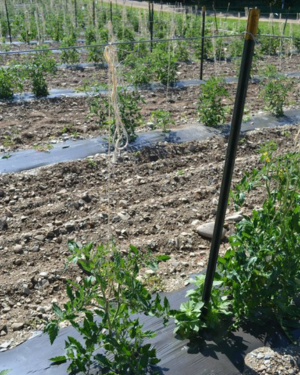
The stake-&-wire/hanging-string system can be used both in the field and in protected-culture settings, and works well for pruned, indeterminate tomatoes.
This system makes it easy to prune and trellis indeterminate tomatoes because each stem gets a string, and any additional suckers are pruned off.
An indeterminate tomato plant with five or six fruiting clusters can exert 10–12 pounds of downward pull on its trellis, so pruning is essential, and the support system needs to be both tall and strong.
Stake & Wire / Hanging-String Set-Up
- Stakes & Wire
To set up a hanging-string trellis, start with tall, strong posts, driven into the ground every 20', with a line of strong wire, such as 12-gauge high-tensile wire, stretched tightly, between the posts.
If wooden or steel T-posts are used, a hole can be drilled at the top of each post through which the wire can be threaded and secured. If you are a welder, you may be able to burn the holes more quickly through metal T-posts. Steel U-posts come predrilled, eliminating this step.
- Hanging Strings
A length of twine is tied to the wire at every point where a vine will be suspended, and then loosely tied at the base of the plant with an overhand knot. Hanging strings made of biodegradable sisal trellis twine facilitate clean-up at the end of the plants' lifecycle.
- Tips
It is important not to make the knot at the base of the plant too tight, because it will cut into the plant as it grows. You can use a tomato trellis clip to attach the string instead of a knot. Tomato trellis clips are designed to bite onto the string securely, but to gently encircle the vinestalk.
As the vines grow, they can be attached to the string with additional trellis clips, or they can be twisted around the string to support the plants. Just make sure you always twist in the same direction, or you will unwind the string you have already twisted!
This method is more labor intensive, but works better for pruned indeterminates, than the basket-weave method.
In the Hoophouse: Lower & Lean, Hook & Wicket
The hanging-string method as described above can be used in a hoophouse, but within protected-culture settings it is more common to run pipes or wires above the crop rows, to which you can attach the hanging strings (see photo) together with some combination of hooks, wickets, and clips or tapes, perhaps with a hand-held, single-click system. These options eliminate the need to pound posts inside your hoophouse, plus allow for a taller trellis to last through the longer hoophouse season.
Variations on the hanging-string method in a greenhouse or hoophouse can involve the use of mobile hooks such as Tomahooks or Rollerhooks to attach the overhead strings. These are strong and conveniently allow the vines to be shifted so they do not outgrow the vertical space of the structure. Mobile hooks can include a spool for attachment at the overhead wire and, when the plants run out of growing space, you can play out some of the string, about a foot at a time, and shift the plants one position to the side so the vines don't pool up at the bottom and break. This requires plants to be planted in double rows, 2' apart being a common spacing, so the plants situated at the ends of rows can be trained around to the other side.
With a lower & lean variation, the proximal portion of the vine is supported by the trellis, and the distal, growing end of the vine is lowered and leaned as the plant matures. With the hook & wicket system, in contrast, sheer stress on the vine (that could occur with lowering and leaning) is avoided by laying the proximal portion of the vine horizontally across a series of wickets as the plant grows and vertically supporting the distal growing point with the moveable hook.
Two key advantages of both these methods, when executed consistently with proper pruning, are that they keep the indeterminate vines healthy and you or your workers down off the ladder.
Review our Greenhouse Tomato Trellising and Pruning Recommendations Tech Sheet for more detailed instructions on installing these systems.
Stake & Trellis-Netting System
Hortonova Trellis Usage • Comparison Chart • PDF
View all Trellis Netting options…
One variation on the hanging trellis system that can be set up either in the field or a protected culture setting uses trellis netting instead of hanging strings to support the vining crop.
Netting Trellis Set-Up
The first step of installation is just like the hanging-string method, where tall posts with holes at the top of them are pounded every 20'. With this method, as you are threading the heavy-gauge wire through the tops of the posts, you weave it through the mesh at the top of a piece of vertically oriented Hortonova.
As the plants grow up, the vines can be clipped to the Hortonova with trellis clips or tucked and weaved into the square mesh. We use this method on my farm for cherry tomatoes, because sometimes we like to let our cherry tomatoes develop more than two heads, and the mesh can accommodate any number of heads. This method also works well for crops like climbing beans or peas that don't have a discrete number of vines.
Learn More about Tomato Trellising
- Lower & Lean Tutorial • Video
- Basketweave tutorial, by Will Brownback, Spiral Path Farm, Perry County, Pennsylvania • Video
- Basketweave tutorial, by Mark Hutton, University of Maine Cooperative Extension • Video
- Basket-weave Trellising Instructions • Tech Sheet (PDF)
- Greenhouse Tomato Pruning & Trellising • Tech Sheet (PDF)
- 3 Ways to Choose Tomatoes: Growth Habit, Growing Environment, Fruit Characteristics • Article
- Johnny's Determinate Tomato Varieties • Comparison Chart (PDF)
- Johnny's Indeterminate Tomato Varieties • Comparison Chart (PDF)
- University of Georgia Commercial Tomato Production Handbook • PDF
- View all our Crop Supports & Trellising Supplies…


